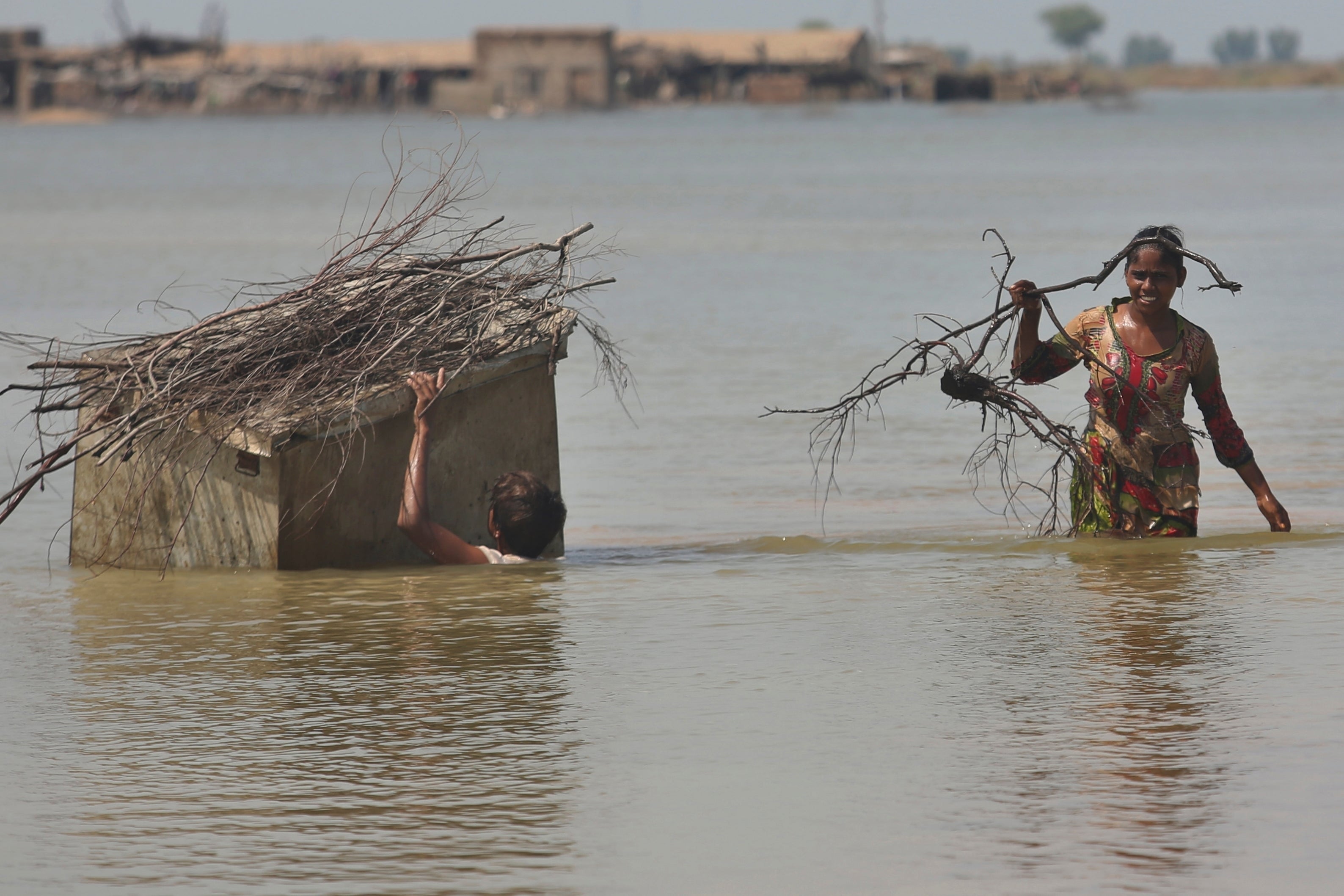Pakistan breaches lake to help save city from flooding as death toll climbs to 1,300
Pakistani engineers cut into embankment for one of country’s largest lakes
Authorities in flood-hit Pakistan have breached the country’s largest freshwater lake, displacing around 100,000 people from their homes but saving more densely populated areas from flood water.
Engineers cut into an embankment of Lake Manchar to release rising waters in the hopes of protecting about half a million people who live in the city of Sehwan and the town of Bhan Saeedabad.
Although it aims to save more heavily populated areas, villages that are home to 100,000 people are in the path of diverted waters.
Manchar Lake, which is used for water storage, had already reached dangerous levels and the increased pressure posed a threat to surrounding areas in southern Sindh province, Sindh irrigation minister Jam Khan Shoro said.
It comes as officials predicted more monsoon rain was on the way for the country’s already devastated south.
“By inflicting the breach we have tried to save Sehwan town. Water levels on Johi and Mehar towns in Dadu district would be reduced by this breach in the lake,” Mr Shoro said.

The hometown of Sindh province’s chief minister was among the affected villages, the residents of which were warned to evacuate ahead of time, the government said.
More than 1,300 people have died and millions have lost their homes in the flooding caused by unusually heavy monsoon rains in Pakistan this year that many experts have blamed on climate change.
In response to the unfolding disaster, UN secretary general Antonio Guterres last week called on the world to stop “sleepwalking” through the crisis. He plans to visit flood-hit areas on 9 September.
Several countries have flown in supplies, but the Pakistani government has pleaded for even more help, faced with the enormous task of feeding and housing those affected, as well as protecting them from waterborne diseases.
While floods have touched much of the country, the Sindh province has been the most affected.

With meteorologists predicting more rain in the coming days, including around Sindh’s Lake Manchar, and its level already rising, authorities ordered that water be released from it.
Sindh’s chief minister, Murad Ali Shah, made the call even though his own village could be flooded, said Sharjil Inam Memon, the provincial information minister.
The hope was that the water, once released, would flow into the nearby Indus River, but the lake’s level continued to rise even after the cut was made, according to Fariduddin Mustafa, administrator for Jamshoro district, where the affected villages are located.
Authorities have also warned residents of the neighbouring Dadu district that they might be at risk of more flooding in coming days.
While the release valve was created in one area, army engineers worked elsewhere to reinforce the banks of Lake Manchar, which is the largest natural freshwater lake in Pakistan and one of the largest in Asia.
In its latest report, Pakistan’s National Disaster Management Authority put the death toll since mid-June – when monsoon rains started weeks earlier than usual – at 1,314, as more fatalities were reported from flood-affected areas of Sindh, Khyber Pakhtunkhwa and Baluchistan provinces. The report said 458 children were among the dead.

Rescue operations continued on Sunday with troops and volunteers using helicopters and boats to get people stranded out of flooded areas to relief camps, the authority said.
Tens of thousands of people are already living in such camps, and thousands more have taken shelter on roadsides on higher ground.
Hira Ikram, a physician at a camp established by Britain’s Islamic Mission in Sukkur charity, said many people had scabies, gastrointestinal infections and fevers.
Prime Minister Shahbaz Sharif, who is visiting flood-affected areas and relief camps daily, called for more international help on Sunday.
“With over 400 [children] dead they make up one-third of overall death toll. Now they are at even greater risk of water borne diseases, Unicef and other global agencies should help,” he tweeted.
Unicef delivered tons of medicine, medical supplies, water purifying tablets and nutritional supplements to Pakistan on Sunday.
Alkidmat Foundation, a welfare organisation, said its volunteers used boats to deliver ready-to-eat meals and other help for residents as well as animal feed on a small island in the Indus. The group also distributed food and items needed by those living by the roadside.
In the country’s northwest, in Khyber Pakhtunkhwa, the provincial disaster management authority warned of more rains, possible flash floods and landslides in the coming week in Malakand and Hazara districts.
Taimur Khan, spokesman for the authority, urged residents on Sunday not to go to any of the areas already flooded in recent weeks.
According to initial government estimates, the devastation has caused $10bn in damage, but planning minister Ahsan Iqbal said on Saturday “the scale of devastation is massive and requires an immense humanitarian response for 33 million people”.
Aside from historic rainfall, southern Pakistan has had to contend with increased flooding as a surge of water flowed down the Indus river.
The country has already received nearly three times the 30-year average rainfall in the quarter through August, totalling 390.7mm (15.38 inches). Sindh province, with a population of 50 million, was hardest hit, getting 464 per cent more rain than the 30-year average.
Being downstream on the Indus river, the southern parts of the country have witnessed swelling river waters flowing from the north. Pakistan’s limited dams and reservoirs are already overflowing and cannot be used to stop downstream flows.
Join our commenting forum
Join thought-provoking conversations, follow other Independent readers and see their replies
Comments


Bookmark popover
Removed from bookmarks